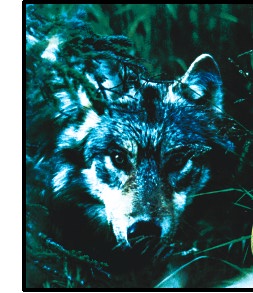
|

|

|

|
| |
 |
|
|
Claiming a victory for the Endangered Species Act, Interior Secretary Bruce Babbitt announced this summer that the U.S. Fish and Wildlife Service plans to move gray wolves off the endangered species list. "Wolves are a living symbol of the regard Americans have for all things wild," Babbitt said in a press release. "We as a people have made the choice to do the right thing and bring these animals back from the brink of extinction." But the environmentalists that have fought hardest for wolf recovery see another side to this story. "Fish and Wildlife's proposal isn't a national vision," says Bob Ferris of Defenders of Wildlife. "It's an exit strategy." Ferris says delisting wolves while they are still confined to less than 5 percent of their historical range is a capitulation to the right-wing political forces who have fought the wolf as the living symbol of all things wild, predatory and federally protected. When wolves were placed on the Endangered Species list in 1974, they had been
With the newfound protection of the Endangered Species Act, the gray (or timber) wolf began a gradual recovery. Wolves as a species are social animals that depend on an intricate pack structure for survival. But at any given time, 10 to 15 percent of the population are lone wolves, mostly young animals that have left packs in the hopes of finding mates and establishing a new pack. As these lone wolves explore new territory, they leave their marks, and gradually other wolves filter in and new packs are established. Through this process gray wolves living in Canada and Minnesota developed self-sustaining populations in Montana, Wisconsin and Michigan by the mid-'90s. Without endangered status, wolf advocates say, the lone wolves that started those populations would have all been killed by hunters, farmers or state wildlife agencies. But as wolves returned, the seeds of rural distrust of wolf recovery were planted. For a Minnesota dairy farmer already beleaguered by market forces and multinational agricultural conglomerates, having the government call shooting a shotgun into the air to scare off the gray wolf that is eyeing your herd the illegal harassment of an endangered animal can be downright disheartening. Organized opposition to wolf recovery comes largely from ranchers' organizations in states where wolves are returning. "Wolves were extirpated for a reason," says Sharon Beck of the Oregon Cattlemen's Association, which is fighting the reintroduction of wolves in that state. "You can't have livestock production or huntable wildlife when wolves are around." But contrary to the predictions of wolf opponents, wolves have not ravaged surrounding livestock in two of the most ambitious projects for wolf recovery: the reintroduction of wolves to Idaho and Yellowstone Park. Wolf predation near Yellowstone has averaged less than the 19 cattle and 68 sheep per year predicted in the reintroduction plan's environmental impact statement, says Ed Bangs, chief of the Fish and Wildlife Service's Northern Rockies wolf recovery program. In comparison, livestock producers in the greater Yellowstone ecosystem average yearly losses to disease and weather of 8,300 cattle and 13,000 sheep. Where wolves have re-established themselves, Bangs notes, "we have seen a lot of the hysteria and extreme positions die down. People see they are not going to snatch children from playgrounds and they are not going to balance nature and make us all better people. They are just animals that do some neat things, but sometimes they also do things we don't like." With self-sustaining gray wolf populations in Yellowstone, Idaho, Montana and the Upper Great Lakes States, the government is ready to delist the wolf and declare its work done. "The Endangered Species Act does not require that animals be restored over their historic range. It only requires that we bring them back from the brink of extinction," says Ron Refsnider of the Fish and Wildlife Service, who authored the wolf reclassification and delisting proposal. Under the Fish and Wildlife Service plan, existing wolf populations would be reclassified as a threatened species as a prelude to removing all federal protection from the wolves. Under threatened status, the existing wolf populations will retain federal protection, but Fish and Wildlife officials can kill wolves that are killing livestock, rather than relocate them as is required for endangered animals. Once all federal protection is removed, which Bangs says could happen as soon as 2003, it will mean the end of federal wolf reintroduction efforts. The management of existing wolf populations and any future reintroduction programs will depend upon state governments. "This proposal cripples any future reintroduction efforts," says Ferris of Defenders of Wildlife. He co-authored a report titled "Places for Wolves" that identifies numerous additional areas--such as the wilderness of California, Nevada, Oregon and Washington State--where wolves could be reintroduced or allowed to repopulate with minimal impact on human economic activity. And while Ferris praises Fish and Wildlife's decision to leave the door open to wolf recovery in Maine, he says that even that option will depend on the state taking action. "If wolf recovery had been left up to the states there wouldn't be any wolves in the lower 48 states," Ferris says. State governments also have proven to be much more easily swayed by the rhetoric and lobbying of those opposed to wolf recovery. Asked to produce a wolf management plan for its robust wolf population, Minnesota's legislature approved a plan that included a $150 bounty on wolves. (Environmentalists have sued to block that plan.) Colorado still has a bounty on wolves, even though they are extinct there. Even after delisting, gray wolves would be subject to federal monitoring and could be placed back on the federal endangered list if states fail to manage them responsibly, but wolves that roam into new territory, such as the Idaho wolves that are starting to roam into Oregon, would have no protection and could be shot on sight. Last year a female wolf named B-45 crossed into Oregon from Idaho searching for a mate. Under pressure from legislators favorable to the livestock lobby and the Oregon State Wildlife Agencies, the Fish and Wildlife Service captured B-45 and returned her to Idaho. Ferris insists that this was an illegal action. "The minute she crossed into Oregon she qualified as endangered," he says. Bangs responds that his agency has the authority to remove Idaho wolves that cross the Oregon border. He adds, however, that the Fish and Wildlife Service has decided not to remove any future wolves that roam into Oregon unless the wolves attack livestock or cause other problems. Oregon Sen. Gordon Smith introduced legislation this summer that would have required Fish and Wildlife to remove any future wolves that roam into the state. Smith, who consistently portrays himself as one of those newfangled, eco-friendly suburban Republicans, chose to insert the anti-wolf language as an anonymous rider to this year's Senate Interior Appropriations Bill. Beck of the Oregon Cattlemen's Association says the original language of the bill "came from us," explaining that the goal of the rider was to keep wolves out of Oregon as long as they have endangered protection. However, the Clinton administration intervened to water down the language to a suggestion that the Fish and Wildlife Service be more attentive to local concern about returning wolves. But while Babbitt was heralding the federal government's success in saving wolves, it was the opponents of wolf recovery who welcomed the proposed reclassification and delisting. "They never should have been protected in the first place," Beck says. xxx"We think the delisting is a step in the right direction," adds Rick Krause, a lawyer for the American Farm Bureau Federation, a conglomerate of insurance companies that operate under the auspices of a nonprofit organization devoted to promoting agricultural interests. The Farm Bureau has been among the leading opponents of wolf recovery, suing to stop wolf reintroduction efforts in Yellowstone and the Southwest. Fighting wolf recovery has been part of a larger Farm Bureau campaign to weaken the Endangered Species Act. "We believe that modern society cannot continue to operate on the basis that all species must be preserved at all cost," reads the Farm Bureau's 1999 policy manual. The Farm Bureau also has portrayed wolf recovery as a federal land grab. "The whole wolf program was a fraud," writes Jake Cummins of the Montana Farm Bureau on the group's Web site. "The real goal was to use the Endangered Species Act to expand federal land use control." Yet while whipping up opposition to wolves among rural people as a symbol of its devotion to the welfare of family ranchers, the Farm Bureau simultaneously has been lobbying for policies that favor the multinational agricultural conglomerates and threaten those ranchers' futures. This is the hidden irony of wolf recovery: The opposition to the gray wolf's comeback shows how powerful interests can use an endangered animal to distract the people most harmed by their policies. Refusing to coexist with wolves was gospel to the great-grandparents of the ranchers now opposing the return of wolves. But now these ranchers are themselves threatened by the rise of a new agricultural system in which multinational corporations control the prices ranchers get for livestock. Across the country, Farm Bureau affiliates and cooperatives are intertwined with agricultural multinationals. To cite an example from "Amber Waves of Gain," a report on the Farm Bureau compiled by Defenders of Wildlife, the Idaho Farm Bureau's affiliated insurance companies own $500,000 in bonds from agribusiness giant Archer Daniels Midland. The report also describes how the Farm Bureau quietly lobbied against Minnesota Sen. Paul Wellstone's 1999 bill that would have placed an 18-month moratorium on agribusiness mergers, while posting a letter on its Web site blaming President Clinton for not backing the bill. "The Farm Bureau represents the monied interests," says Joel Dyer, author of Harvest of Rage. "If they can blame the economic pressure on family ranchers on environmentalists and wolves, it distracts attention. The family rancher is threatened, but it doesn't have anything to do with wolves. It's because three companies control the market for beef." Like the spotted owl in the Northwest, the battle over wolf recovery has been used by corporate interests to drive a wedge between natural allies--threatened family ranchers striving to preserve the integrity of their land, and environmentalists trying to preserve and restore threatened ecosystems. In this light, Fish and Wildlife's decision to begin the process of delisting wolves, essentially limiting them to their current range, represents a lost opportunity. Learning to coexist with wolves encourages the kind of dialogue between environmentalists and rural people that could result in better land-use policies. Vast areas of California, Nevada, Oregon and Washington State could
support populations of gray wolves, but most likely will never see
a wolf again under the current Fish and Wildlife proposal. Unless
there is a great public outcry, Babbitt's decision to declare victory
in the wolf wars and withdraw federal support will close off America's
remaining wild areas to wolves. "Having wolves in an area gives
people the idea that area is wild," Ferris says. "Shutting the door
on wolves shuts the door on that area ever being wild." Kevin Burke is a writer in Portland, Oregon. Readers interested in viewing the proposal to reclassify and delist the gray wolf can find it at http://www.midwest.fws.gov/wolf. Until November 13, the Fish and Wildlife Service is accepting public comments on the proposal at graywolfcomments@fws.gov.
|

